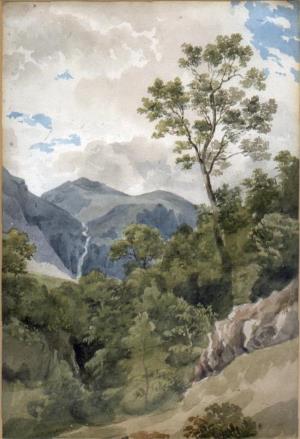The Hydro
Will the Anafon Hydro affect the Aber Falls?

Watercolour by A E Penley 1807-1870 ©A.G.Gatehouse
No, not at all. The Afon Anafon flows down a separate valley to the east of the Aber Valley. By the time the Afon Anafon meets the Afon Rhaeadr Fawr from the Falls just upstream of Bontnewydd, all the water from the turbine house will have been discharged back into the river.
What is the lifespan of the hydro scheme?
The concrete footings will be built to last well beyond the initial 40-year lease we have on the land. The turbine is expected to last as long. It is not unknown for hydro systems to last for approaching 100 years without major problems.
How much income will the hydro generate?
For the first 20 years, our financial projections indicate that the Anafon Hydro will generate revenue of approximately £200,000 a year, made up from the sale of electricity and the Government subsidy on renewable energy generation, the Feed-in-Tariff. Thereafter, the income will be derived solely from the sale of electricity unless there are further government subsidies.
What is the Feed-in-Tariff?
The Feed-in-Tariff (FiT) is a government subsidy administered by the energy regulator Ofgem to encourage the development of renewable energy generation. The Anafon Hydro project receives a FiT worth approximately 3 times the current sale price of electricity per KWh generated.
What will be the hydro’s operating costs once it is up and running?
Operating costs will include:
- weekly checking and maintenance (largely carried out by local volunteers);
- annual maintenance checks;
- rent;
- business rates;
- insurance;
- administration;
- contingency;
- technical services.
What will happen to the profits made by Ynni Anafon Energy?
All disposable profits generated by the hydro will be gift-aided to a new community charity, Dŵr Anafon, set up by the Abergwyngregyn Regeneration Company to distribution them for the benefit of local communities.
How will revenue be spent by YAE once the hydro is fully operational?
The Directors intend that the revenue from the generation, sale and export of electricity by YAE will be used to cover operating costs each year as follows:
- legal requirements, e.g. Financial Conduct Authority fees;
- necessary administrative services and insurance;
- any maintenance, repair etc. for the generating equipment;
- a contingency fund to cover unexpected events and spare parts for the equipment;
- payment of the interest and capital on any loans;
- payments to the community charity, D for the benefit of local communities;
- payment of interest to our investors.
What happens to my shares if I die?
If a Member dies, the repaid value of the shares will normally be added to the estate for probate purposes. You have the option to nominate a recipient for the value of the shares in the event of your death. If you have claimed EIS tax relief, you will be able to avoid Inheritance Tax on the shares if you include them in your will.
Can I hold shares on behalf of children?
Members must be at least 16 years of age. An investor has the option of holding shares on behalf of someone who is under 16 but these shares are held in trust until the child is 16 (the investor is “the trustee”). Therefore the shares are the personal property of the trustee until the child reaches 16 years old. If the trustee were to be a Member in his/her own right, this would imply that he/she would be a Member twice over, potentially entitled to two votes. As this is not permitted, a trustee owning shares on behalf of a child cannot be a Member in their own right.